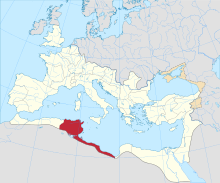Semta (Africa)

Semta was a
Africa Proconsularis that is tentatively identified with ruins at Henchir Zemba (Dzemda) [1] Carthage, Tunisia near the Oued el Kebir 20 km (12 mi) southwest of Zaghouan[2] at 36.269282, 9.887345.[3]
Ruins
The site has been excavated and those excavations revealed three different building complexes:[4]
- a 40 m × 50 m (130 ft × 160 ft) rectangular building,
- a 4 m (13 ft) high mausoleum and,
- two further buildings, one of which is called the Byzantinefortress, measuring 40 m × 30 m (131 ft × 98 ft).
Numerous inscriptions have been found there.[5]
Bishopric
The ancient city was also the seat of an ancient
Only two bishops are known from Semta. The Catholic Maggiorino attended theReferences
- ^ Brent D. Shaw, Sacred Violence: African Christians and Sectarian Hatred in the Age of Augustine (Cambridge University Press, 2011 ).
- ^ Barington Altas.
- ^ "Semta, Henchir-Dzemda – Digital Atlas of the Roman Empire".
- ^ Semta, Henchir Dzemda.
- ^ Louis Poinssot & Robert Lantier, Q. Geminius Sabinus, Princeps peregrinorum Comptes rendus des séances de l'Académie des Inscriptions et Belles-Lettres (1923) Vol 67, Num 3 pp. 197-201.
- ^ Semta at catholic-hierarchy.org.
- ^ "Apostolische Nachfolge – Titularsitze". Archived from the original on 2019-01-19. Retrieved 2016-12-21.
- ^ Semta at gcatholic.org (English)
- ^ J. Mesnage, L'Afrique chrétienne, (Paris, 1912), p. 63.
- ^ Le Petit Episcopologe, Issue 127.
- ^ Revue des Ordinations Épiscopales, Issue 1955, Number 71.
